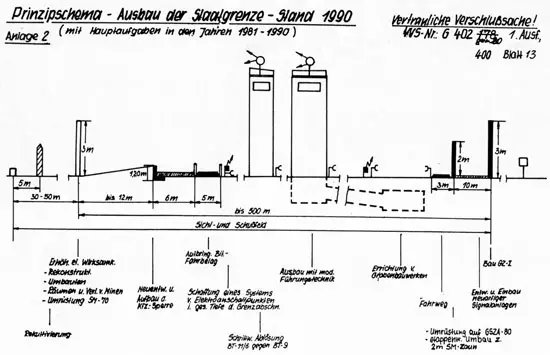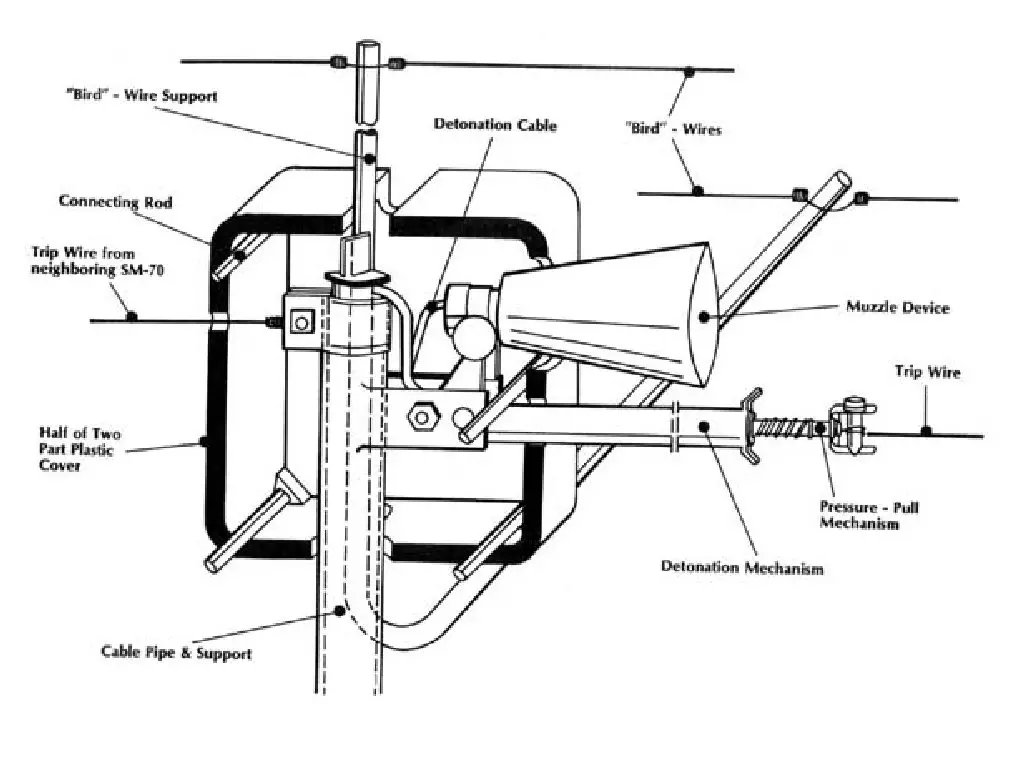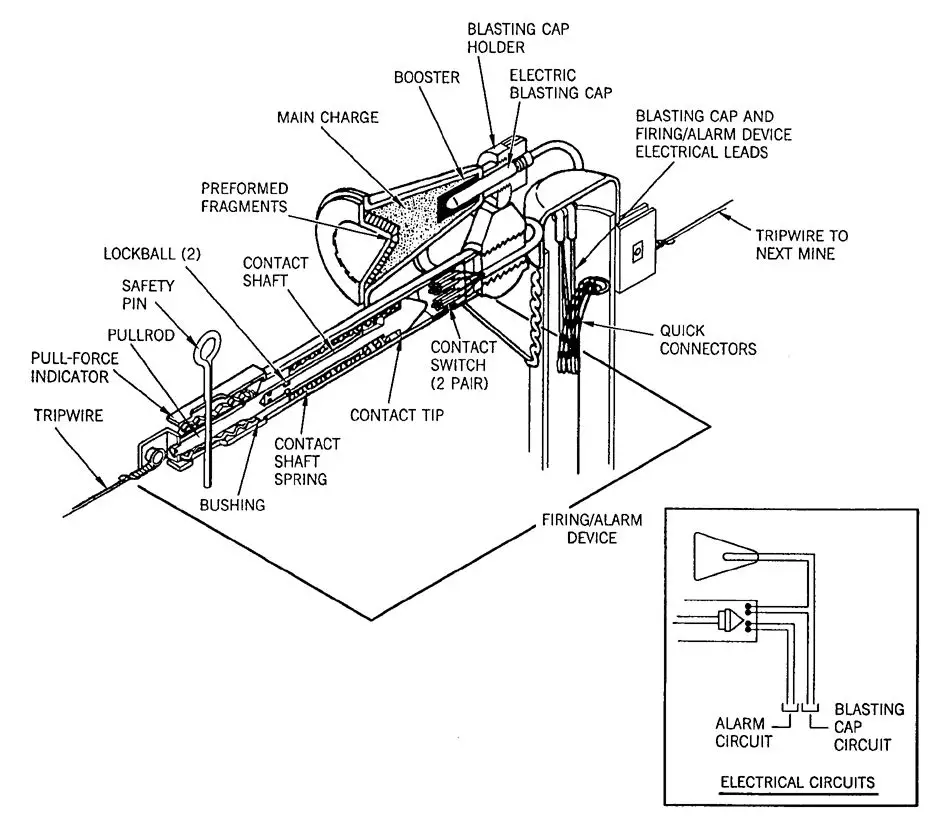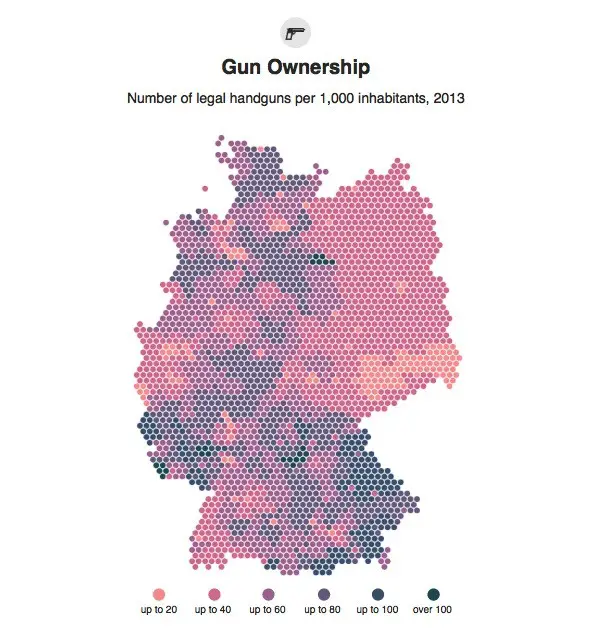This pretty heat-map of pinks and blues shows legal handgun ownership in today’s (well, 2013’s) Germany. What’s interesting is that you can clearly see the inter-German border that existed during the period from 1949-1992, caused when the Soviet Occupation Zone stood up as the Soviet satellite (slave) state of the German Democratic Republic (East Germany), and the three Western Allies’ (FR, UK, US) Occupation Zones joined as the Federal Republic of Germany. In 1989 the Soviets lost control of their East German subjects and the long process of German reunification began. Here’s the map, from a feature on the lasting divisions in unified Germany in the newspaper Die Zeit.
In the former East Germany, even though the gun laws originally followed those of East Germany, replacing the Soviet-era complete handgun ban, the limited gun culture of West Germany has not taken root. This is not entirely surprising, as many of the more malleable youth of the eastern Bundesländer have migrated West in search of jobs and adventure, and the East is heavily populated by older residents who grew up under the Hammer-and-Dividers symbol of the East German Communist party, the SED.
One wonders what happened to the inter-German border, which as late as the 1980s was characterized by guard towers, dog runs, plowed earthen areas to expose any footprints, free-fire zones, and several types of land mines (on the inner-German border only; they were removed from the Berlin Wall by 1980).

General Arrangement – Construction of the Steel Border – Plan for 1990. Confidential restricted material! (reads the German title). W. Germany on left. SM-70 mines are on the inside of the fire 3m-high fence or wall.
All East Germans living within a certain distance of the wall (100 meters, in Berlin) had to register with the Volkspolizei, and were subject to removal if background checks showed them to be insufficiently enthused by the Workers’ and Peasants’ Revolution imposed at the point of Russian bayonets. An intensive network of informants were the Vopo’s eyes and ears. Even the VoPos were kept out of the border zone, though; there were special GrenzPolizei, Border Police, selected for political reliability — and absence of any personal connection to the West or to the borderlands. Maps of the DDR were blank on the BRD side, and were even blank on the DDR side, for the last 5 kilometers from the border.1
Mines deployed along the border included a variety of Russian military types (most lifted by 1985) and a home-grown Claymore equivalent, the Splittermine 1970 or SM-70.2 A German legend attributed the design of the SM-70 to an SS officer intent on securing concentration camps. That’s possible, because East Germany was all about giving brutal Nazis a second chance as brutal Communists, but doesn’t seem to have documentary support.
The SM-70 contained a hollow charge of TNT, but where a typical hollow-charge weapon like an RPG’s PG-7 warhead would be lined with a copper, aluminum alloy or exotic-metal alloy lining to explosively-form a plasma armor-penetrating projectile, the SM-70’s cone comprised preformed metallic fragments. It could be fired by electrical command wire, tripwire, or both. (Tripwire installations were most common). The mines were monitored; if an SM-70 fired, a display panel would inform the guard force where to collect the dead or wounded would-be escapee.

General arrangement of an SM-70. They were typically mounted in rows of three, at ankle level, at about 1.45 m, and about 5 CM below the top of the wall or fence, on the East German side of the last wall (or chain-link or expanded-mesh fence) before freedom.
The SM-70 was installed on the DDR side of the border fences. At least 60,000 SM-70s were deployed, 13,000 of them in a single 40-km long field. When the mines were tested in 1970, wildlife that were collaterally killed by the machines were left lying in the border strip as a warning to would-be “Border violators.”

This shows the innards of the SM-70 and how it works. They were never observed outside of East Germany.
The end of life of the SM-70 is to a degree uncertain. Officially, they were all removed by the end of 1984, but some seem to have persisted longer. Reportedly, they were replaced by monitoring systems that led to response by human and canine patrols. Had East Germany continued, its border authorities planned an even richer sensor environment. Given their political reliability problems with their police and military, the more they could automate the Wall, the better.
So we wondered, what has become of that death zone, that grim barrier that in practice turned an entire nation into a concentration camp? As it happens, the Germans wasted no time tearing it down, and now there is barely any remnant of it left to memorialize the hazards and the many victims of Communism’s need for captive populations.
The inter-German border was the strongest and most sophisticated of these Cold War fortifications, but some version of it did indeed extend “from Stettin on the Baltic, to Trieste on the Adriatic.” (The most futile and least well-imagined of them was further East, in Communist but anti-Soviet Albania). But they couldn’t, in the end, keep the people in and freedom out. In the end, like the Maginot Line, or Hadrian’s Wall for that matter, these walls fell less because of their own weaknesses (they had plenty; US and Allied intelligence agencies and SOF could play them like a Stradivarius), but because of the vulnerabilities in the humans that operated them.
The Die Zeit page has a video; unfortunately we can’t embed it here, but it is a Google Earth flyover of what much of the inner-German border has become: greensward, zigging and zagging along a now-erased border. Now, environmentalists are resisting redevelopment of the area, which has become host to many rare flora and fauna. Quite a remarkable thing, to those of us who looked on it, from whatever side, and expected it to be permanent.
Ozymandias was not available for comment.
Notes
1 Rottman, Gordon L. Berlin and the Intra-German Border 1961-89. Botley, Oxford, UK: Osprey Publishing, 2008. pp. 37-40.
2. Rottman, op.cit., pp. 17-23.
Additional References
SM-70. Grenades, Mines and Boobytraps website. Retrieved from: http://www.lexpev.nl/minesandcharges/sovietbalkan/germanyddr/sm70.html
DDR Grenzsperranlagen: Grenzzaun u. Selbstschußanlage. Website. Retrieved from: http://www.grenzanlagen.de/05_metallgitterzaun.htm
(the whole Grenzsperranlagen website is good, but it’s all in German).

Kevin was a former Special Forces weapons man (MOS 18B, before the 18 series, 11B with Skill Qualification Indicator of S). His focus was on weapons: their history, effects and employment. He started WeaponsMan.com in 2011 and operated it until he passed away in 2017. His work is being preserved here at the request of his family.


22 thoughts on “Handgun Ownership, German Reunification, and a Unique Wall Weapon”
When can we expect books about the SF behind the Wall adventures?
There won’t be because the SF never worked behind the wall. We had the equivalent of the SMLM Soviet Military Liaison Mission on their side operated by the CIA.
SF qua SF as I said did not even have a wartime mission across the Wall, post 1982, with the singular exception being the then-classified SF element, Detachment A, Berlin Brigade. The SF elements focused on Europe were focused on strategic reconnaissance deep in the rear of a presumably advancing Soviet Army, or stay-behind UW operations and E&E networks, which were almost as compartmented as Det A.
The USMLM was not a special operations or CIA mission, it was an Army Intelligence mission. It had teams of one officer observer who was a 3/3 or better Russian speaker and one NCO driver who was a 3/3 or better German speaker. Like the Soviet mission in the West, the US (and separate UK) mission in the east could in theory go anywhere and see anything; in practice they were sometimes impeded by the opposing team. These missions were an artifact of the four power treaty, and had something approximating diplomatic immunity. This did not stop Russians in one GSFG training area from killing the officer. The NCO got away, and later in his career joined SF. (He happened to be in my Phase II cohort, but not my light weapons class. I think he was a heavy-weapons guy. Good guy).
LOL, I still have my SMLM card.
I remember getting briefed by USMLM when I was in a LRS company. Mainly about vehicle recce and using the photos they had taken to show us different variants of Warsaw Pact vehicles and the markings on them.
On the heat map of handgun ownership: do you have any insight on the distribution within West Germany? Bavaria seems to have a high rate, for example, and the Rhineland/Palatinate has a lot higher rate than their neighbors in Westphalia. Just curious about what might drive that – differences in regional culture, or did the areas have different laws, or ????? The five-fold differences are pretty striking.
Gun law’s been national in Germany since the 1920s at least, through Weimar, Nazi, and BRD eras. There have even been periods of outright ban (the Occupation) which obviously was not completely honored.
Currently there is no data on the regional distribution of gun licenses. The centralized National Firearms Register started 2013 to collect details previously held only by the local authorities.
Firearms laws
The Northwest has a strong club culture
http://zeus.zeit.de/bilder/2009/14/leben/zeit-magazin-leben/deutschlandkarte/14-deutschlandkarte-2.jpg (club members as percentage of population, missing out on a few clubs)
with members owning a small number of firearms (one Olympic rifle, or few handguns) or sticking to air rifles/pistols.
In the forested areas
http://www.dlr.de/DesktopDefault.aspx/tabid-832/1332_read-2590/gallery-1/gallery_read-Image.1.1155/
the hunters tend to own a greater number of guns (think roe deer rifle, boar rifle, shotgun, brush gun, fox rifle etc, plus 2 or more handguns).
The East has yet to recover from the bolshevist ban of private gun ownership, with an unknown number of unregistered ex-soviet firearms in private hands.
Currently there is no data on the regional distribution of gun owners, only on gun numbers.
http://www.zeit.de/2014/04/waffen-deutschland
The centralized National Firearms Register started 2013 to collect details previously held only by the local authorities.
Firearms law was handled differently in the various regions favouring ownership in conservative Bavaria, Palatinate and Baden-Wuerttemberg (the south), very restrictive in the socialdemocrat-ruled states of the Northwest.
The Northwest has a strong club culture
http://zeus.zeit.de/bilder/2009/14/leben/zeit-magazin-leben/deutschlandkarte/14-deutschlandkarte-2.jpg (gun club members as percentage of population)
with members owning a small number of firearms (one Olympic rifle, or few handguns) or sticking to air rifles/pistols.
In the forested areas
http://www.dlr.de/DesktopDefault.aspx/tabid-832/1332_read-2590/gallery-1/gallery_read-Image.1.1155/
the hunters tend to own a greater number of guns (think roe deer rifle, boar rifle, shotgun, brush gun, fox rifle etc, plus 2 or more handguns).
The East has yet to recover from the bolshevist ban of private gun ownership, with an unknown number of unregistered ex-soviet firearms in private hands.
Here is a news report about a study that asked why certain areas in Germany had more legal guns. Around Neustadt there seems to be a high concentration of hunters (who usually own at least three weapons, and I’ve heard it’s usually a hunting rifle, small pistol for coup de grace shots (on game), and a shotgun and a .22 trainer).
In Amberg it’s gunclubs and collectors. A police spokeshole exclaimed surprise at the numbers and wondered at the lower than average gun crime, and crime in general there. Well, I don’t. Further, it was speculated that many people inherit weapons. Not sure if the dude in I think Hamburg who had a 20mm Flak 38 in his garage inherited it, or was just an unusually keen duck-hunter. I wonder just how many interesting curios and relics are squirreled away in cellars, attics, garages and barns.
Finally, the article whines about deaths by weapons, but plays a little loose with the truth; lumping in misuse of offcial weapons and suicides with other legal weapons like knives and axes, and trying to paint the legal gunowners with the same brush.
Not that long ago there was another whiny article in the local paper complaining about the shockingly high percentage of gun ownership in Franconia; even the little amount we still have, someone wants taken away. They don’t seem to be that keen on reining in the illegal guns though; for that they’d have to rummage around in the multi-culti enclaves, and that is verboten because diversity and history (WCO stfu).
http://www.br.de/nachrichten/mittelfranken/hohe-waffendichte-franken-bayern-100.html
Re: Gunownership in Germany
5.4 mio registered firearms
1.4 mio registered owners (hunting, sport, collectors, security)
10-40 mio unregistered ‘illegal’ firearms
ww2 relics
pre-72 rifles and shotguns (legal purchases, ‘failed to register’ after changes in firearm legislation)
ex-russian army guns
smuggling from Eastern Europe across open borders
2000 gun-related crimes/yr
700 gun-related suicides/yr
70 gun related murders/yr
http://de.wikipedia.org/wiki/Waffenmissbrauch#Deutschland
A more detailed map of regional distribution
http://www.zeit.de/2014/04/waffen-deutschland
In 1984 West-Germany paid the communists 1bn Deutschmark ‘credit’ to have the SM-70 and all other mines removed.
http://www.grenzanlagen.de/grenzsperr1.htm
Hognose Post author
Some of the sources do say that the SM-70s were all removed by 1985. We were still training SM-70 defeat methods when I left active duty in 1987, but that could have been just inertia on our part. And they were still in the GrenzPo’s plans, as the sketch shows. To the best of my knowledge, the Ossis never used them for things like airfield or other critical-installation security.
Now, most of those installations were off our target list and on SAS’s circa 1982 because the CIA’s “desk” for East Germany was confident that “there is zero resistance potential” and “East Germans are extremely satisfied with their lot and proud of their country, and wouldn’t reunify even if GFSG left.” Of course, the same asshat thought East Germany has a higher standard of living than West. So East Germany was judged impossible and … the cousins said, “we’ll take that.” I should try to get those EG desk analyses declassified because scholars would die laughing at how badly off the mark they were.
So the only US element that had targets in East Berlin or East Germany was Det A. (SOF element, I mean. I’m sure the zoomies had a huge target array, mostly GSFG related).
A tad off topic but had a personal experience with a friend of a friends son from Germany stay with me for a month (Around 99′ or 00′). He said the West Germans had no love for the East Germans. They were lazy, living off the gov’t cheese, and if they did have jobs the West Germans resented it. Communists did a good job of destroying any incentive in these people I guess.
I loved this article because I love history. I’m a little slow, can you elaborate the connection between the gun ownership post fall and the old security situation? Is it because the West is still suspicious today or don’t trust East Germans to this day?
Thanks
> Maps of the DDR were blank on the BRD side, and were even blank on the DDR side, for the last 5 kilometers from the border.
I read about Soviet maps which left off cities they didn’t want foreigners (or natives) to know about, and laughed. But some years later I was reading about Cuba, and realized I didn’t know precisely where it was. So I turned to my handy globe… and didn’t find it. I looked in my late-1960s atlas, and didn’t find a map showing it, though there was an entry about it. Dominican Republic, Jamaica, Grenada, Bermuda, check. Cuba? No Cuba.
Finally I turned to the internet, and found that Cuba is a freakin’ big island right off the tip of Florida. Best as I can remember, none of the globes or maps we had in school in the late ’60s-’70s showed Cuba either.
I expect sea maps always showed Cuba, as it would be a menace to navigation otherwise, but it sort of evaporated from scholastic and mass-market maps, I’m assuming this happened sometime after an unfortunate incident1961…
So German maps that didn’t show the “other” Germany… yeah, I totally understand how that can work.
Au contraire.
Just checked a Diercke Schulatlas from 1971 (West-German) and some old roadmaps from the same period.
No white areas east or west of the border.
That’s very bizarre. I can’t recall a map that didn’t have Cuba, and I grew up in that period. Sometimes, on official US maps, you would see some snippy note that the State Department did not recognize this border or that. And Taiwan was noted as the “Republic of China” and we didn’t really admit the Reds had won the Civil War in 1949, until about 30 years later. But I never heard of an island or physical feature disappearing from a western or US map.
I have seen maps of areas in other countries where a military base or something is marked “restricted area” and blank.
The US did compel Google to alter some Google overheads. For example, raw satellite imagery of the white house shows some details of the roof, that are kind of an amorphous blob at Google. Of course, Google is in NSA’s pocket….
And from there it would seem a very short step for Google to ‘paint in’ some feature the NSA desired, just for the disinformation value.
So are the armchair amateurs that poke around looking at Russian sub bases around Severodvinsk seeing Photoshop? And can we trust any Google images of Iran?
My observations based on my three years living outside of Nuremberg from 1967 to 1970 when I was in the army were that more wealthy Germans who members of shooting and hunting clubs would go through a year long gun skills and safety course which was expensive and upon completion they were licensed to own a variety of guns. I think the price was equal to about $1,000 US which was a lot of money in the late 60’s. A new VW was $1,400.
I also remember seeing all the Bavarian shooting clubs who would march along with their families in the opening parade for the Oktoberfest in Munich. My take on that it that there are a lot of the equivalent of rednecks with old family traditions of owning and shooting firearms. Of course a lot of nice guns have been made in Germany for a number of years especially around Oberndorf so that might affect gun ownership too.
I have no idea how all the Green Party liberals mix into the distribution but I would think they are in cities and they are against private ownership of firearms. So that would mean that rich folks with estates and shooting rights own firearms and maybe a nice collection and middle class Kraut rednecks with family traditions make up most of the rest of the ownership.
Once again these are just perceptions by on information over 40 years old.
The Ossies (meaning folks from the former DDR, not Utopia del Sud, the last semi-civilised English speaking nation) are a mixed bunch. The old ones that grew up in the Worker’s Paradise seem to regret the loss, remembering full employment and more cohesion, particularly at work. When I remind them about the long queues to empty shops, VoPos, Stasi, and the Antifa Shutzmauer, the conversation dwindles. It is estimated that one in four was a “volunteer helper” of the Stasi: yes, fully a quarter were snitches, and they don’t cease that mindset just because the regime is a little different, for now. A couple of years back the deputy head of the BKA (German FBI) lamented how much easier his job was in the “good old days”…yes, just as the DDR inherited the goons of the Third Reich, the New Germany recycled the goons in turn.
The young ones are different but still exude a strong aura of Homo Sovieticus, as do many of our former Warsaw Pact region, er, workers, to use a generous term. But even the modern descendants of the Wessies are a fairly dismal lot; schooled to swim with the crowd and follow the current, thinking verboten, they can be merciless to anyone that dares swim against the current. Jealousy, fear, shame, with conditioning, encouragement and immunity helpfully supplied. Yuri Bezmenov was right about de-moralisation; it takes a generation or two, but once accomplished is indelible.
Back to on-topic with the OP…
My father had a Henry Rifle in .22, an M1 Carbine copy by Erma also in .22, and an air rifle, not sure whether it was Anschutz or Weihrauch. We emigrated from West Germany to Australia in 1976, but even back then the German regulations were onerous, especially compared to Australia pre-1996; but he as a non-Citizen was able to legally own and responsibly use weapons even if it did mean jumping through a lot of bureaucrapic hoops. Connections helped as did favours and mordida. It must have been ironic, seeing he grew up in occupied Belgium, took part in the occupation of Germany, dropped in to spread a little cheer and goodwill in the Congo, and indulged in a little private pest-control versus some Fedayeen that interrupted his holiday in Israel, 1967. In 1955 he was in an army light aviation squadron in the French Sector, near Cologne. On one CC flight his copilot opened a window and the slipstream sucked out all the maps, which pleased the pilot no end. The weather wasn’t so nice, so they landed to get directions from a local. The farmer was frightened and asked if they were being invaded. It turns out they’d strayed across the BRD/DDR border. They lost little time in correcting that…because an invitation at the point of a gun is not easily refused, which I guess is the whole point of being selective as to who may or may not have them, and being invited to stop the oppression already or else bang is such a party pooper.
You’re describing humans there, I think.
I have had one of those Erma .22 M1 Carbines and they are great handling little rifles. I have an M1 .30 carbine and it is fun to start a new shooter on the .22 and then transition to the .30 which has slightly more recoil. Once those are mastered I move them on to the 6.5 Swedish and that is enough gun to kill any deer in Texas.
I bought my Erma 30 years ago and like there few other German made guns I own it is a good dependable gun that always goes bang when the trigger is pulled. Sometimes I think we did a little bit to much demilitarization when we began the occupation of Germany after WWII with all of the super liberal stuff they are dealing with now.
So how did SOF deal with the plowed-earth? Did they jump over.. ? Walk over it backwards to give the impression of someone escaping?
Or were they dropped off behind it from quiet planes flying at night?
WP air defense seems fairly feckless in aftermath. People escaped from WP countries sometimes by plane and flew without getting detected, which suggests there was no aerial radar cover.
A couple of more adventurous ones by hang-glider. Though, most popular way was booking a holiday in Yugoslavia..